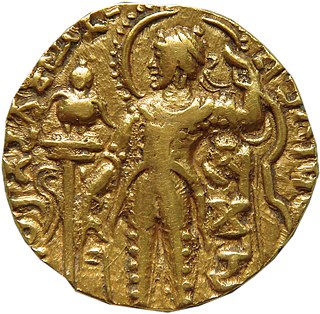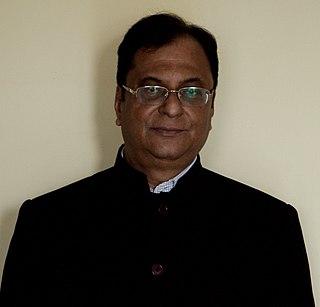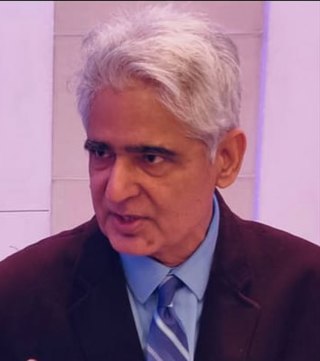
D. P. Agrawal (Dharmapal Agrawal) is a historian of Indian science and technology, archaeologist, [1] and author. He has published works on Indian archaeology, metallurgy, the history of science, and palaeoclimate.

D. P. Agrawal (Dharmapal Agrawal) is a historian of Indian science and technology, archaeologist, [1] and author. He has published works on Indian archaeology, metallurgy, the history of science, and palaeoclimate.
Dharma Pal Agrawal was born on 15 March 1933 at Almora, United Provinces of British India (presently in Uttarakhand). [2]
He has worked with the Archaeological Survey of India, Tata Institute of Fundamental Research and Physical Research Laboratory, all of which are All-India institutions. His researches were mainly done in the fields of palaeoenvironment, prehistoric archaeology, radiocarbon & TL dating, archaeometallurgy, India's contributions to the world of science and technology. At the Physical Research Laboratory, he was a Senior Professor and Area Chairman of the Quaternary Paleo-Climate Study Area, a large multi-disciplinary research group. [3] [4] He has been a visiting professor at the University of Pennsylvania and at the International Research Center at Kyoto, [2]
Agrawal has made significant contributions to the fields of paleoenvironment, pre-historic archaeology, radiocarbon dating, the archaeology of metallurgy, and the history of science and technology in India. He has edited the journal Man and Environment for a number of years, and served on the advisory board of journals World Archaeology and Le anthropologie. He is a fellow of the National Academy of Sciences. [4] and a member of the National Commission on the History of Science. During his academic career he has published 15 books and about 250 papers on different topics. [3] [5]
After retirement from the Physical Research Laboratory in 1993, he has been working as the Honorary Director of the Lok Vigyan Kendra in Almora, where he coordinates research on "traditional knowledge systems," codifying the accumulated folk knowledge on the crops, medicinal plants and biodiversity. He is also the chief editor of a multi-volume international project on the history of science and technology. [3]
The 1971 book Copper Bronze Age in India reports an integrated study of the Copper-Bronze Age carried out at the Tata Institute of Fundamental Research, covering its chronology, technology and ecology. [6]

The Bhimbetka rock shelters are an archaeological site in central India that spans the Paleolithic and Mesolithic periods, as well as the historic period. It exhibits the earliest traces of human life in India and evidence of the Stone Age starting at the site in Acheulian times. It is located in the Raisen District in the Indian state of Madhya Pradesh, about 45 kilometres (28 mi) south-east of Bhopal. It is a UNESCO World Heritage Site that consists of seven hills and over 750 rock shelters distributed over 10 km (6.2 mi). At least some of the shelters were inhabited more than 100,000 years ago.
Indraprastha is mentioned in ancient Indian literature as a city of the Kuru Kingdom. It was the capital of the kingdom led by the Pandavas mentioned in Mahabharata. Under the Pali form of its name, Indapatta, it is also mentioned in Buddhist texts as the capital of the Kuru mahajanapada. Modern historical research pin its location in the region of present-day New Delhi, particularly the Old Fort. The city is sometimes also known as Khandavaprastha or Khandava Forest, the name of a forest region on the banks of Yamuna river which had been cleared by Krishna and Arjuna to build the city.

The history of metallurgy in the Indian subcontinent began prior to the 3rd millennium BCE. Metals and related concepts were mentioned in various early Vedic age texts. The Rigveda already uses the Sanskrit term ayas. The Indian cultural and commercial contacts with the Near East and the Greco-Roman world enabled an exchange of metallurgic sciences. The advent of the Mughals further improved the established tradition of metallurgy and metal working in India. During the period of British rule in India, the metalworking industry in India stagnated due to various colonial policies, though efforts by industrialists led to the industry's revival during the 19th century.

Kalibangān is a town located at 29.47°N 74.13°E on the left or southern banks of the Ghaggar in Tehsil Pilibangān, between Suratgarh and Hanumangarh in Hanumangarh District, Rajasthan, India 205 km. from Bikaner. It is also identified as being established in the triangle of land at the confluence of Drishadvati and Sarasvati Rivers. The prehistoric and pre-Mauryan character of Indus Valley civilization was first identified by Luigi Tessitori at this site. Kalibangan's excavation report was published in its entirety in 2003 by the Archaeological Survey of India, 34 years after the completion of excavations. The report concluded that Kalibangan was a major provincial capital of the Indus Valley Civilization. Kalibangan is distinguished by its unique fire altars and "world's earliest attested ploughed field". It is around 2900 BC that the region of Kalibangan developed into what can be considered a planned city.

Braj Basi Lal was an Indian writer and archaeologist. He was the Director General of the Archaeological Survey of India (ASI) from 1968 to 1972 and has served as Director of the Indian Institute of Advanced Studies, Shimla. Lal also served on various UNESCO committees.
Gregory Louis Possehl was a professor emeritus of anthropology at the University of Pennsylvania, United States, and curator of the Asian Collections at the University of Pennsylvania Museum of Archaeology and Anthropology. He was involved in excavations of the Indus Valley civilization in India and Pakistan since 1964, and was an author of many books and articles on the Indus Civilization and related topics. He received his BA in anthropology from the University of Washington in 1964, his MA in anthropology from the University of Washington in 1967, and his PhD in anthropology from the University of Chicago in 1974. He conducted major excavations in Gujarat, Rajasthan (Gilund), and in January 2007, began an excavation at the UNESCO World Heritage site of Bat in the Sultanate of Oman.

The Varman dynasty (350–650) was the first historical dynasty of the Kamarupa kingdom. It was established by Pushyavarman, a contemporary of Samudragupta. The earlier Varmans were subordinates of the Gupta Empire, but as the power of the Guptas waned, Mahendravarman (470–494) performed two horse sacrifices and the status of Kamarupa as an independent state remained unimpaired. As per the Apsad Inscription of Adityasen, Susthivarman was defeated by Mahasengupta on the bank of Lauhitya. The first of the three Kamarupa dynasties, the Varmans were followed by the Mlechchha and then the Pala dynasties.

Dilip Kumar Chakrabarti is an Indian archaeologist, Professor Emeritus of South Asian Archaeology at Cambridge University, and a Senior Fellow at the McDonald Institute for Archaeological Research, Cambridge University. He is known for his studies on the early use of iron in India and the archaeology of Eastern India.

The horse has been present in the Indian subcontinent from at least the middle of the second millennium BC, more than two millennia after its domestication in Central Asia. The earliest uncontroversial evidence of horse remains on the Indian Subcontinent date to the early Swat culture .While horse remains and related artifacts have been found in Late Harappan sites, indicating that horses may have been present at Late Harappan times, horses did not play an essential role in the Harappan civilisation, in contrast to the Vedic period. The importance of the horse for the Indo-Aryans is indicated by the Sanskrit word Ashva, "horse," which is often mentioned in the Vedas and Hindu scriptures.

Indigenous Aryanism, also known as the Indigenous Aryans theory (IAT) and the Out of India theory (OIT), is the conviction that the Aryans are indigenous to the Indian subcontinent, and that the Indo-European languages radiated out from a homeland in India into their present locations. It is a "religio-nationalistic" view on Indian history, and propagated as an alternative to the established migration model, which considers the Pontic–Caspian steppe to be the area of origin of the Indo-European languages.

This is a bibliography of notable works about the historical Indian subcontinent as well as the modern-day Republic of India.
Kanmer, locally known as Bakar Kot, is an archaeological site belonging to Indus Valley civilization, located in Rapar Taluk, Kutch District, Gujarat, India.
Adya Rangacharya, known as R.V. Jagirdar till 1948, later popularly known by his pen name Sriranga, was an Indian Kannada writer, actor and scholar, and a member of the Adya Jahagirdar family. He was awarded the Sangeet Natak Akademi Fellowship in 1967 and the Sahitya Akademi Award for literature in 1971 for Kalidasa, a literary criticism in Kannada.

Vidya Dehejia is a retired academic and the Barbara Stoler Miller Professor Emerita of Indian and South Asian Art at Columbia University. She has published 24 books and numerous academic papers on the art of South Asia, and has curated many exhibitions on the same theme.
Katragadda Paddayya is an Indian archaeologist, Professor Emeritus and a former Director of Deccan College, known to have introduced two major perspectives in archaeological theory and methodology. He was honored by the Government of India, in 2012, with the fourth highest Indian civilian award of Padma Shri.

The history of Uttar Pradesh, a state in India, stretches back several millennia. The region shows the presence of human habitation dating back to between 85,000 and 73,000 years ago. Additionally, the region seems to have been domesticated as early as 6,000 BC.

Anurag Sharma is an Indian physicist and a professor at the department of physics of the Indian Institute of Technology Delhi. He is known for his pioneering researches on optoelectronics and optical communications and is an elected fellow of all the three major Indian science academies viz. Indian Academy of Sciences, Indian National Science Academy and National Academy of Sciences, India as well as Indian National Academy of Engineering. The Council of Scientific and Industrial Research, the apex agency of the Government of India for scientific research, awarded him the Shanti Swarup Bhatnagar Prize for Science and Technology, one of the highest Indian science awards for his contributions to Engineering Sciences in 1998.

Archaeology in India is mainly done under the supervision of the Archaeological Survey of India.

Kalyan Kumar Chakravarty is an Indian historian, art historian, writer, action anthropologist, academician and administrator, known for his intercultural and cross-disciplinary research and activism. A retired officer of the Indian Administrative Service (IAS) of the 1970 batch, he was appointed Chairman of the Lalit Kala Akademi, India’s federal fine arts academy, in 2013.

K. T. S. Sarao or Karam Tej Singh Sarao is the former head and professor of Buddhist Studies at the University of Delhi. Sarao has been a visiting professor/fellow at Dongguk University, Chung-Hwa Institute of Buddhist Studies, Preah Sihanouk Raja Buddhist University, St Edmund's College, Cambridge, Maison des Sciences de L'Homme, University of Toronto, and Visva-Bharati University.